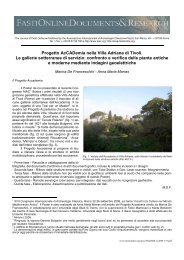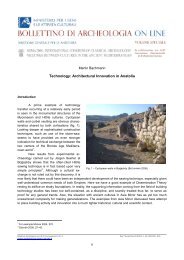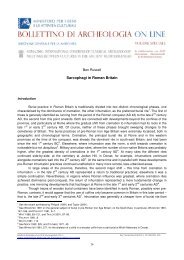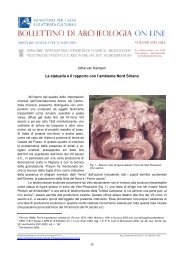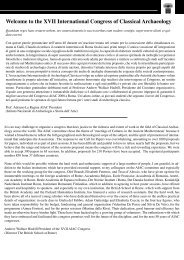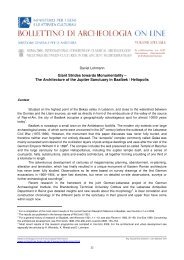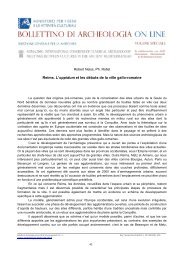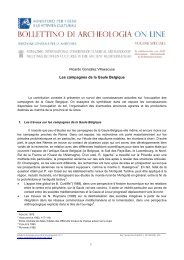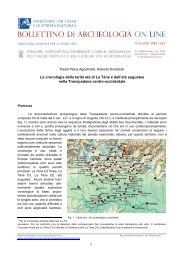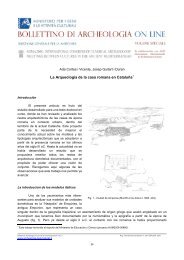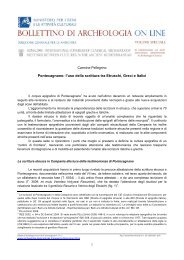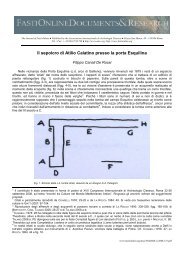Tabula Siarensis - Bollettino di archeologia on line - Ministero per i ...
Tabula Siarensis - Bollettino di archeologia on line - Ministero per i ...
Tabula Siarensis - Bollettino di archeologia on line - Ministero per i ...
Create successful ePaper yourself
Turn your PDF publications into a flip-book with our unique Google optimized e-Paper software.
BOLLETTINO DI ARCHEOLOGIA ON LINE II, 2011/2-3<br />
<str<strong>on</strong>g>di</str<strong>on</strong>g> Germanico (uxo]/re [eius) tra i parenti c<strong>on</strong>sultati: 47 in realtà all’epoca del senatoc<strong>on</strong>sulto<br />
Agrippina doveva ancora tornare da Antiochia c<strong>on</strong> le ceneri del marito. 48<br />
Riassumendo: la relatio, come spiega G<strong>on</strong>zález, 49 rivela che il Senato ha deliberato sugli<br />
<strong>on</strong>ori e, <str<strong>on</strong>g>di</str<strong>on</strong>g> fr<strong>on</strong>te alla <str<strong>on</strong>g>di</str<strong>on</strong>g>versità delle opini<strong>on</strong>i e al timore che la decisi<strong>on</strong>e finale n<strong>on</strong> piaccia a<br />
Tiberio, ha deciso <str<strong>on</strong>g>di</str<strong>on</strong>g> sentire il suo parere, fornendogli le opini<strong>on</strong>i dei senatori. Il verbo riferito<br />
all’im<strong>per</strong>atore è al singolare (legerit), cioè sembra che il Senato abbia deciso <str<strong>on</strong>g>di</str<strong>on</strong>g> sentire solo<br />
l’im<strong>per</strong>atore. Poi Tiberio ha scelto gli <strong>on</strong>ori che sembravano adeguati a lui e ai familiari da lui<br />
c<strong>on</strong>sultati. Perciò l’azi<strong>on</strong>e in<str<strong>on</strong>g>di</str<strong>on</strong>g>cata dal c<strong>on</strong>giuntivo <strong>per</strong>fetto legerit (<strong>line</strong>a 13 = Tab. Siar. I, 6) è<br />
posteriore alla relatio e anteriore al senatoc<strong>on</strong>sulto: ricevuta dal senato la copia sententiarum,<br />
Tiberio avrebbe scelto <strong>per</strong>s<strong>on</strong>almente gli <strong>on</strong>ori opportuni ma, c<strong>on</strong> moderazi<strong>on</strong>e, insieme agli<br />
altri membri della domus Augusta. 50<br />
LINEA 15 = Tab. Siar. I, 8<br />
La riga è completamente priva <str<strong>on</strong>g>di</str<strong>on</strong>g> lettere, poiché il testo doveva terminare nella parte<br />
<strong>per</strong>duta a sin., ma, come si è detto sopra, è risultata f<strong>on</strong>damentale <strong>per</strong> fornire una ricostruzi<strong>on</strong>e<br />
abbastanza verosimile della lunghezza delle righe. Può integrarsi grazie a Tab. Siar. I, 8 51 e alla<br />
formula tra<str<strong>on</strong>g>di</str<strong>on</strong>g>zi<strong>on</strong>ale che doveva introdurre la sententia del Senato, d(e) e(a) r(e) i(ta) c(ensuere).<br />
LINEE 16-17 = Tab. Siar. I, 9-12 = CIL VI 31199a, 1-3<br />
Per prima cosa il Senato decreta che vengano de<str<strong>on</strong>g>di</str<strong>on</strong>g>cati a Germanico tre archi: uno a<br />
Roma, uno sul m<strong>on</strong>te Amano in Siria, e uno sulla riva del Reno: il testo trova corrisp<strong>on</strong>denza,<br />
anche se in maniera meno dettagliata, in Tac. ann. II, 83, 2. L’iscrizi<strong>on</strong>e del Museo <str<strong>on</strong>g>di</str<strong>on</strong>g> Perugia<br />
si interrompe c<strong>on</strong> la descrizi<strong>on</strong>e del primo <str<strong>on</strong>g>di</str<strong>on</strong>g> questi archi, quello romano.<br />
Si poss<strong>on</strong>o aggiungere due parole a Tab. Siar. I, 9-10, 52 <strong>per</strong>mettendoci <str<strong>on</strong>g>di</str<strong>on</strong>g> restituire: Placere<br />
uti ianus marmoreus extrueretur in Circo Flaminio pe[cunia publica et a<str<strong>on</strong>g>di</str<strong>on</strong>g>]tus ad eum<br />
locum in quo statuae ...], dove la spaziatura c<strong>on</strong>sentirebbe, in entrambe le iscrizi<strong>on</strong>i, l’inserimento<br />
della formula <strong>per</strong> esteso pecunia publica, al posto <str<strong>on</strong>g>di</str<strong>on</strong>g> quella abbreviata dell’e<str<strong>on</strong>g>di</str<strong>on</strong>g>tio della<br />
Tab. Siar.<br />
Su questa riga si può sovrapporre anche CIL VI 31199a, 2: Fla]/mi[nio.<br />
Il Senato stabilisce che a Roma l’arco <str<strong>on</strong>g>di</str<strong>on</strong>g> Germanico venga eretto in circo Flaminio, 53 e<br />
più precisamente nel luogo in cui nel 15 d.C. il c<strong>on</strong>sole C. Norbano Flacco (Tab. Siar. I, 10) ha<br />
de<str<strong>on</strong>g>di</str<strong>on</strong>g>cato statue al Divo Augusto e ai membri della domus Augusta. 54<br />
Il termine a<str<strong>on</strong>g>di</str<strong>on</strong>g>tus, escludendo il participio passato del verbo a<str<strong>on</strong>g>di</str<strong>on</strong>g>re attribuibile a ianus (nel<br />
qual caso la c<strong>on</strong>giunzi<strong>on</strong>e et n<strong>on</strong> avrebbe ragi<strong>on</strong>e <str<strong>on</strong>g>di</str<strong>on</strong>g> esistere), sembra piuttosto identificare<br />
un’area da extruere insieme all’arco, che fornisca l’accesso al luogo dove già si trovano le statue<br />
<str<strong>on</strong>g>di</str<strong>on</strong>g> Augusto e dei suoi familiari. È noto come il termine a<str<strong>on</strong>g>di</str<strong>on</strong>g>tus compaia a proposito del <str<strong>on</strong>g>di</str<strong>on</strong>g>ritto <str<strong>on</strong>g>di</str<strong>on</strong>g><br />
iter, actus, a<str<strong>on</strong>g>di</str<strong>on</strong>g>tus, ambitus nei c<strong>on</strong>fr<strong>on</strong>ti delle proprietà sepolcrali e dell’inalienabilità dell’a<str<strong>on</strong>g>di</str<strong>on</strong>g>tus<br />
alla tomba da parte del padr<strong>on</strong>e del f<strong>on</strong>do annesso ad essa. 55 Forse il significato andrebbe collegato<br />
alle osservazi<strong>on</strong>i fatte da Arce e G<strong>on</strong>zalez 56 a proposito dei tre archi postumi de<str<strong>on</strong>g>di</str<strong>on</strong>g>cati a<br />
Germanico: sec<strong>on</strong>do gli stu<str<strong>on</strong>g>di</str<strong>on</strong>g>osi spagnoli si tratta giustamente <str<strong>on</strong>g>di</str<strong>on</strong>g> archi n<strong>on</strong> solo <strong>on</strong>orari o tri<strong>on</strong>-<br />
47) CRAwFORD 1996, p. 516.<br />
46) Arriverà a Roma solo dopo un lungo viaggio (Tac. ann. II, 75,1), all’inizio del 20 d.C. (Tac. ann. III, 1), cfr. GONZáLEZ<br />
2000a, pp. 107 ss.<br />
49) GONZáLEZ 2000a, pp. 103 ss.; 2002, p. 147.<br />
50) La madre e il figlio <str<strong>on</strong>g>di</str<strong>on</strong>g> Tiberio, nominati senza menzi<strong>on</strong>e della parentela ma solo col nome, c<strong>on</strong> l'aggiunta <str<strong>on</strong>g>di</str<strong>on</strong>g> Ant<strong>on</strong>ia, madre<br />
<str<strong>on</strong>g>di</str<strong>on</strong>g> Germanico. GONZáLEZ 2000a, p. 106 s. c<strong>on</strong>fr<strong>on</strong>ta il passo significativo <str<strong>on</strong>g>di</str<strong>on</strong>g> Dio Cass., 56, 47: «Il Senato decretava che Tiberio<br />
ricevesse le <str<strong>on</strong>g>di</str<strong>on</strong>g>verse opini<strong>on</strong>i <strong>per</strong> iscritto e scegliesse quella che gli piaceva», e «tali fur<strong>on</strong>o i decreti approvati in memoria <str<strong>on</strong>g>di</str<strong>on</strong>g><br />
Augusto, nominalmente dal Senato, ma in realtà da Tiberio e Livia».<br />
51) GONZáLEZ 2002, pp. 300, 321.<br />
52) GONZáLEZ 2002, pp. 300, 322 s.<br />
53) GONZáLEZ 2000a, pp. 110 ss.; 2002, pp. 321, 322 s. L'arco è stato localizzato tra la porticus Octaviae e il teatro <str<strong>on</strong>g>di</str<strong>on</strong>g> Marcello,<br />
nel luogo dove nel 22 d.C. Livia de<str<strong>on</strong>g>di</str<strong>on</strong>g>cherà una statua al Divo Augusto, ed è identificabile sul frammento 31 della Forma Urbis<br />
Romae c<strong>on</strong> la traccia <str<strong>on</strong>g>di</str<strong>on</strong>g> un arco a un fornice (uno ianus, appunto) all'estremità nord-est del Circo Flaminio, vicino al portico <str<strong>on</strong>g>di</str<strong>on</strong>g><br />
Ottavia, v. GONZáLEZ 2002, p. 120 nota 256 (c<strong>on</strong> bibliografia).<br />
54) Si tratta del primo riferimento, su un documento pubblico, alla domus Augusta, cfr. GONZáLEZ 2000a, pp. 110 ss.; GONZáLEZ<br />
2002, pp. 308, 351.<br />
55) Cfr. DE RUGGIERO 1961, pp. 70 ss., s. v. actus; TLL I, s.v. a<str<strong>on</strong>g>di</str<strong>on</strong>g>tus, cc. 694 ss.<br />
56) ARCE 1984, p. 152 ss.; GONZáLEZ 2002, p. 134.<br />
www.<str<strong>on</strong>g>archeologia</str<strong>on</strong>g>.beniculturali.it<br />
Reg. Tribunale Roma 05.08.2010 n.30 ISSN 2039 - 0076<br />
13



